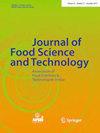Effects of Stresses on the Growth and Cytotoxicity of Shiga-Toxin Producing Escherichia coli in Ground Beef and Spinach
IF 3.3
3区 农林科学
Q2 FOOD SCIENCE & TECHNOLOGY
引用次数: 1
Abstract
The objectives of this study were to examine the effect of stresses on the growth and cytotoxicity of pathogenic Escherichia coli in beef and spinach. A mixture of three strains of Shiga toxin-producing E. coli (STEC) O157:H7 or 4 strains of nonO157 STEC, O26:H11, O103:H1, O104:H4, and O145:NM, was subjected to stress of 2 ppm chlorine, aw 0.97, pH 5, or 15-day starvation. Stressed or non-stressed STEC was inoculated into 5 g of irradiated ground beef or spinach. The cell populations during storage at 8, 12, or 16C for 4 weeks were compared to evaluate the growth variation between O157 and non-O157 STEC. Supernatant from each sample after 24-h incubation at 22C was used to determine Vero-cytotoxicity using [3-(4,5dimethylthiazol-2-yl)-5-(3-carboxymethoxyphenyl)-2-(4-sulfophenyl)-2H-tetrazolium, MTS] or lactate dehydrogenase (LDH) assay to evaluate the effects of stresses on the cytotoxicity exhibited by STEC. After one week at 8C, the population of non-stressed non-O157 (3.1 log CFU/g) was significantly (p 0.05) different in beef and spinach. MTS assay showed that stressed O157 and non-O157 STEC exhibited significantly (p<0.05) higher cytotoxicity than the non-stressed controls. The numbers of surviving Vero cells were 47-52% (stressed) vs. 65% (control) in beef and 20-30% (stressed) vs. 52-53% (non-stressed) in spinach. Similarly, LDH assay also indicated an increased cytotoxicity (p<0.05) in stressed O157 and non-O157 STEC than non-stressed controls in spinach. There was no significant difference among the four stresses in inducing the levels of cytotoxicity in O157 or non-O157 STEC. Results showed that STEC cells exposed to sub-lethal stresses might have increased cytotoxicity during subsequent growth in ground beef or spinach. The findings illustrate the importance of applying suitable control measures to eliminate the presence of stressed STEC in beef and spinach processing environment or their subsequent contamination in the products.胁迫对牛肉和菠菜中产志贺毒素大肠杆菌生长和细胞毒性的影响
本研究的目的是研究应激对牛肉和菠菜中致病性大肠杆菌生长和细胞毒性的影响。将3株产志贺毒素大肠杆菌(STEC) O157:H7或4株非O157 STEC (O26:H11、O103:H1、O104:H4和O145:NM)的混合物置于2ppm氯、aw 0.97、pH 5或饥饿15天的条件下。将应激或非应激产志异大肠杆菌接种到5 g辐照过的牛肉或菠菜中。将细胞群在8、12或16个频率下储存4周,比较O157和非O157 STEC之间的生长变化。采用22℃孵育24 h后的上清液[3-(4,5 -二甲基噻唑-2-基)-5-(3-羧基甲氧基苯基)-2-(4-磺苯基)- 2h -四唑铵,MTS]或乳酸脱氢酶(LDH)法测定细胞毒性,评价应激对STEC细胞毒性的影响。1周后,非应激非o157种群(3.1 log CFU/g)在牛肉和菠菜中差异显著(p 0.05)。MTS试验结果显示,O157胁迫和非O157胁迫的STEC细胞毒性显著高于对照组(p<0.05)。牛肉中的Vero细胞存活率分别为47-52%(应激)和65%(对照),菠菜中的Vero细胞存活率分别为20-30%(应激)和52-53%(非应激)。同样,LDH测定也表明,与未胁迫的菠菜相比,胁迫O157和非O157 STEC的细胞毒性增加(p<0.05)。四种胁迫对O157和非O157产STEC的细胞毒性诱导水平无显著差异。结果表明,暴露于亚致死压力下的产志异大肠杆菌细胞在随后的牛肉或菠菜生长过程中可能会增加细胞毒性。研究结果表明,采取适当的控制措施消除牛肉和菠菜加工环境中应激产志毒素的存在或其随后对产品的污染的重要性。
本文章由计算机程序翻译,如有差异,请以英文原文为准。
求助全文
约1分钟内获得全文
求助全文
来源期刊
CiteScore
7.70
自引率
0.00%
发文量
274
审稿时长
11 months
期刊介绍:
The Journal of Food Science and Technology (JFST) is the official publication of the Association of Food Scientists and Technologists of India (AFSTI). This monthly publishes peer-reviewed research papers and reviews in all branches of science, technology, packaging and engineering of foods and food products. Special emphasis is given to fundamental and applied research findings that have potential for enhancing product quality, extend shelf life of fresh and processed food products and improve process efficiency. Critical reviews on new perspectives in food handling and processing, innovative and emerging technologies and trends and future research in food products and food industry byproducts are also welcome. The journal also publishes book reviews relevant to all aspects of food science, technology and engineering.

 求助内容:
求助内容: 应助结果提醒方式:
应助结果提醒方式:


